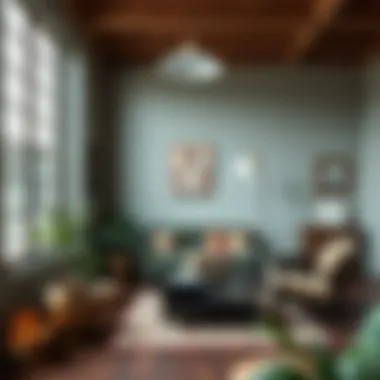Integrating Central Air into Historic Homes: A Guide


Intro
Integrating central air conditioning into historic homes presents a unique set of challenges and opportunities. Homeowners often find themselves at a crossroads, balancing the need for modern conveniences with the desire to honor the architectural integrity and charm of their vintage residences. This article examines the nuances of such a transformation, guiding you through the key considerations and solutions that can enhance the comfort of your home without compromising its historical significance.
From the outset, it’s important to note that adding central air to an older structure is not merely a matter of bolting an outdoor unit to the wall. Various factors come into play—structural elements, aesthetics, energy efficiency, and compliance with local regulations. By the end of this article, homeowners will have a clearer understanding of how to navigate this complex process effectively.
Understanding the Need for Central Air
When considering the integration of central air into historic homes, understanding the need is not just a matter of comfort. It’s about aligning modern conveniences with the character that vintage architecture brings. Air conditioning can dramatically transform the living experience, especially during hot summer months when older structures, often designed with natural ventilation in mind, might struggle to keep interiors cool.
Analyzing Historical Home Characteristics
Historic homes often come with their own set of unique characteristics, like intricate woodwork, high ceilings, and thick walls that tell a story of the past. For instance, houses built in the Victorian style often feature ornate details that can be compromised if installation of cooling systems is not approached carefully. These architectural elements are not just aesthetic; they also play a role in how air flows through the home.
From narrow hallways to intricate moldings, integrating central air requires a deep understanding of these elements. Homeowners should assess whether their home has adequate structure to support ductwork or if alternative cooling methods might be necessary.
Additionally, older homes may lack the insulation or energy-efficient windows found in modern houses, which can make them challenging to cool effectively. A lack of insulation means the central air might work overtime, leading not only to discomfort but also to higher utility bills.
Benefits of Upgrading to Central Air
Moving to central air conditioning offers several notable benefits, particularly in historic homes. Below are some key points to consider:
- Enhanced Comfort: Central air can maintain a consistent temperature throughout the house, unlike window units which often cannot reach every corner. Imagine coming home on a sweltering day and walking into a cool, inviting space.
- Improved Air Quality: Central systems can be equipped with high-quality air filters, which reduces dust and allergens – a notable advantage for those sensitive to seasonal changes. This is particularly helpful when the home might have been sealed tightly for years.
- Added Value: Upgrading to central air can enhance the resale value of historic homes. A well-cooled environment becomes a selling point for future buyers, especially in regions with hot climates.
- Aesthetic Preservation: Unlike window units, central air is hidden from view, preserving the architectural integrity of the home. Many systems can be installed with minimal disruption to the existing structure.
"Central air conditioning not only provides comfort but also preserves the essence of the historic home, merging the old with the new seamlessly."
Ultimately, integrating central air is more than a practical decision - it’s a commitment to enhancing one’s living space without losing the unique qualities that make historic homes special. Taking the time to analyze existing characteristics and weigh the benefits opens the door to a more comfortable and aesthetically pleasing environment.
Assessing Your Home's Structures
Integrating central air conditioning into a historic home can be a challenging yet rewarding endeavor. One crucial phase of this process is assessing your home's structures. Understanding the existing framework, insulation, and ductwork is essential for ensuring that the installation aligns seamlessly with the unique architecture of your historic property. This analysis helps not only in preserving the character of the home but also in optimizing comfort and energy efficiency.
Inspecting Insulation and Energy Efficiency
Before proceeding with any kind of installation, it's vital to inspect insulation throughout the house. Many older homes were constructed with materials and methods that are no longer up to modern standards. Checking for adequate insulation in attics, walls, and basements can lead to significant improvements in energy efficiency.
A home without proper insulation can lead to discomfort and high energy bills, especially in extreme weather conditions. Homeowners should look for signs such as drafts, cold spots, or even uneven heating and cooling. Addressing insulation issues may involve upgrading materials to meet contemporary standards, which could involve adding foam board, spray insulation, or even blown cellulose, depending on the structures present in the house.
Benefits of Assessing Insulation
- Lower Energy Costs: Improved insulation can cut energy bills considerably over time.
- Enhanced Comfort: A well-insulated home maintains a better temperature, mitigating temperature fluctuations.
- Noise Reduction: Adequate insulation can help in dampening noise coming from outside.
Evaluating Existing Ductwork
When planning to install central air, evaluating the existing ductwork is a pivotal step. In many historic homes, the original duct systems may not be compatible with modern air conditioning systems. Homeowners should ask themselves questions like:
- Is the current ductwork too small or too large for the new system?
- Are there any leaks or blockages?
- Is the ductwork made from appropriate materials to handle air conditioning?
An efficient duct system ensures balanced airflow throughout the home. If the existing ductwork is inadequate, reconfiguring or replacing it completely might be necessary. This could involve either resizing the ducts or employing a more intricate design to direct air efficiently.
Key Points to Consider
- Airflow Balance: Properly sized ducts accommodate flow rates, which is critical for even heating and cooling.
- Material Suitability: Duct material impacts energy efficiency; metal ducts tend to add more value but may require more visible installation.
Dealing with Low Ceilings and Limited Space


Solutions for Low Ceilings
- Using Slim Duct Systems: Some air conditioning systems come with slimline duct options, which are designed for tighter spaces.
- Placement Considerations: Strategically positioning air conditioning units away from low-ceiling areas can create a more efficient system. If possible, keep central units high up where they have ample clearance for airflow.
- Mini Split Systems: Another alternative is to use ductless mini split systems that don’t require extensive ductwork and can be mounted near the ceiling, further maximizing floor space.
In sum, assessing the structures of your historic home plays an integral role in ensuring a successful integration of central air. The balance between modern functionality and historic preservation must be maintained, creating a comfortable, efficient space that respects your home’s architectural history.
Choosing the Right Air Conditioning System
When it comes to integrating central air conditioning into historic homes, selecting the right system is crucial. This choice not only affects comfort but also impacts energy consumption, aesthetic harmony, and overall functionality within vintage spaces. Knowing the options available can greatly influence your experience and satisfaction, particularly in how seamlessly the system can blend into your home’s existing architecture.
Types of Central Air Systems
Understanding the different types of central air systems available is vital. Here’s a breakdown of the most common types you might consider:
- Split Systems: These consist of an outdoor compressor unit and an indoor air handler. Split systems work well in many historic homes because they require less invasive ductwork.
- Packaged Systems: These units combine all components into a single outdoor unit. While they save indoor space, they may not always be suited for older homes' aesthetics.
- Ductless Mini-Split Systems: Perfect for homes without existing ductwork, these systems allow for targeted cooling and heating in specific rooms. They can be less disruptive during installation and preserve a home's historical integrity.
Each of these systems carries its advantages, and selecting the right one depends on the specific structural and design considerations of your home.
High-Efficiency Options
A high-efficiency central air conditioning system not only keeps your home comfortable, but it can also save you money on energy bills in the long run. Look for units with a high Seasonal Energy Efficiency Ratio (SEER) rating, which indicates how effectively the air conditioner operates. A higher rating typically means lower energy costs, which is a win-win for both your wallet and the environment.
Moreover, many high-efficiency systems come with advanced features that enhance performance:
- Variable Speed Compressors: These adjust cooling output based on the current temperature, optimizing energy usage without compromising comfort.
- Smart Thermostats: These devices learn your schedule and preferences to ensure your system runs only when necessary, further reducing energy consumption.
Investing in a high-efficiency system is not just a financial decision—it’s also a commitment to sustainability, a value many homeowners treasure today.
Considerations for Zoned Systems
Zoned systems are becoming increasingly popular among homeowners looking to integrate air conditioning into older homes. This approach allows you to control the temperature in different parts of the home independently, which is especially useful in multilevel or irregularly shaped residences.
Here are some key considerations when exploring zoned systems:
- Building Layout: Older homes often have unique architecture that may necessitate custom ductwork or specialized controls. Analyze how your specific layout can benefit from zoning.
- Usage Patterns: Consider which areas of your home are used most frequently and which are not. Zoning can help maintain comfort where you need it most.
- Costs vs. Benefits: While zoned systems can carry a higher upfront cost, they often result in reduced energy usage and increased comfort, making them a worthy consideration for the long haul.
"Choosing the right air conditioning system is akin to selecting the perfect piece of furniture for your lineage home—both need to fit the space and reflect its character."
Installation Techniques for Older Homes
When it comes to installing central air conditioning in historic homes, the process can often feel like threading a needle in a haystack. You’ve got to balance modern technology with the integrity of a prized piece of history. Older homes possess charm and character that new builds can't match, but retrofitting them with contemporary air systems requires careful planning and expertise.
Hiring Qualified Professionals
Engaging licensed professionals is crucial. Why? Because installing central air isn’t just about slapping a unit in the basement and calling it good. Experts who specialize in historic renovations will understand what makes your home tick and will have the skills necessary to navigate its unique challenges. They’ll assess your home’s architecture and design so that you don’t inadvertently compromise its aesthetic appeal. Think of it like hiring a fine artist to restore a masterpiece instead of getting a painter from down the block.
When looking for these professionals, consider asking:
- What past experience do you have with historic homes?
- Do you have references I can contact?
- Can you provide a detailed proposal that outlines the project from start to finish?
Getting answers can protect you from future headaches.
Challenges of Retrofitting Ductwork
One of the biggest headaches in integrating central air into an older home is the ductwork. Many historical residences lack the infrastructure for traditional duct systems. Ducts can take up a lot of space and may not blend in well with the existing architecture.
Homeowners might find themselves at a crossroads, with options that include:


- Building new ducts: This can be costly and may require significant renovations to the walls and ceilings.
- Utilizing existing spaces: Sometimes, you can retrofit ducts into existing areas like crawl spaces or attics, but that often means navigating uneven spaces.
- Mini-splits or high-velocity systems: In situations where traditional ducts won't fit, these alternatives can deliver cooling effectively with less invasive installation.
Each option has pros and cons, and your contractor will help you weigh these based on your individual home layout.
Alternative Systems for Limited Spaces
If your vintage home poses restrictions on ductwork, don't lose hope. Several innovative alternatives can still provide comfort without compromising your walls, ceilings, or overall aesthetic.
- Ductless mini-split systems: These are becoming quite popular in older homes. Instead of ducts, these systems use wall-mounted units for both cooling and heating. They’re versatile and can be hidden quite nicely, often resembling artwork instead of machinery.
- High-velocity systems: These allow for smaller ducts that can be squeezed into tight spaces, providing adequate airflow without visible intrusion. They work by utilizing a small, high-pressure system to distribute air, maintaining the historical integrity.
Choosing the right alternative system is like picking the perfect accessory for an outfit; it should enhance the overall look without overshadowing it.
"Retrofitting central air in older homes is about finding balance - the past meets the present in a comfortable compromise."
In summary, integrating centralized air conditioning into an older home doesn't have to be a nightmare. With the right professionals and innovative techniques, you can ensure that modern convenience doesn’t overshadow the vintage charm of your home.
Maintaining the Integrity of Your Home
Incorporating central air conditioning into historic homes presents an opportunity to blend comfort with preservation. Central air, while modern and efficient, can, if done correctly, honor the unique characteristics of the home’s original structure. It’s not only about functionality — it’s also about ensuring that the essence of the home remains intact. The emotional connection that homeowners have with their properties often stems from the architectural features, historical importance, and personality that these buildings embody. Therefore, when evaluating installation options, it becomes crucial to maintain the integrity of your home.
Preserving Architectural Features
One of the primary considerations in retrofitting a historic home with central air is the preservation of architectural features. Homeowners should approach this with the mindset that every change can influence the home's overall aesthetic. For instance, homes built in the Victorian era often display ornate trim, curvy staircases, and detailed moldings that characterize their unique style.
When planning for central air, the contractor's aim should be to work around existing structures rather than forcibly altering them. Consider using concealed ductwork that can hide in the spaces between walls or beneath floors, preventing visible changes to prominent features. Moreover, installing registers and grills that complement the existing design, such as choosing antique-finished pieces, can help integrate the new system naturally. Understanding the original design allows homeowners to enhance rather than detract from the home's architectural sensitivity.
Visual Impact of New Installations
The visual impact of new installations in historic homes shouldn't be underestimated. Homebuyers often look past the structural aspects of air conditioning to focus on how it changes the interiors of a beloved space. A stark, modern vent on a lovingly restored period wall can feel out of place and cause friction between traditional charm and contemporary needs.
To mitigate these concerns, consider the following options:
- Color Matching: Paint duct covers or vents to match the wall colors or finishes.
- Discreet Designs: Opt for low-profile designs that blend seamlessly into the environment.
- Placement Strategy: Thoughtfully position vents in less conspicuous areas, like hallways or rooms used less frequently, where their visual footprint has less impact.
"The goal is to create harmony between the old and the new, ensuring that central air becomes an invisible benefit to the homeowner, rather than a visible hindrance."
In conjunction with these visual strategies, collecting feedback from local historical societies or architects experienced in preservation can provide valuable insights. They can often suggest methods to install modern conveniences without compromising the unique visual narrative of these age-old structures.
By focusing on preserving architectural features and minimizing the visual impact of installations, homeowners can successfully integrate central air without losing what makes their historic home special. This balance is essential, allowing for a comfortable living environment while still respecting the past.
Energy Efficiency and Sustainability
Incorporating central air conditioning into historic homes presents a unique opportunity not just to enhance comfort, but to do so in a manner that respects the environment. Given that vintage homes often come with their own set of architectural and infrastructural quirks, considering energy efficiency and sustainability becomes imperative. These elements are not only beneficial for the planet but can also lead to significant cost savings in the long run.
When we discuss energy efficiency, it fundamentally refers to using less energy to provide the same level of comfort. For homeowners, this translates into reduced utility bills and a lower carbon footprint. In historic homes, where original materials and systems might lead to higher energy consumption, upgrading to a central air system that emphasizes efficiency can help bridge the gap between modern needs and traditional charm.
Sustainability, closely tied to energy efficiency, emphasizes the need to utilize resources judiciously and with minimal impact on our surroundings. For instance, opting for systems that use eco-friendly refrigerants or those designed to minimize waste during installation, aligns with a sustainable approach. Homeowners are encouraged to fully understand their energy consumption and how modern central air systems can greatly improve their home's overall efficiency while preserving its character.
Benefits of Energy Efficiency and Sustainability
- Cost Savings: Energy-efficient systems can drastically reduce monthly electric bills.
- Increased Home Value: Modern, energy-efficient upgrades can make historic properties more appealing to potential buyers.
- Eco-Friendly Choices: Minimizing energy waste directly contributes to a healthier environment.
- Preservation of Original Materials: Sustainable practices often mean less wear and tear on aging infrastructure.
A small investment in energy-efficient upgrades can lead to substantial savings for homeowners in the long run.
As homeowners contemplate integrating central air, they shouldn't overlook the significance of energy efficiency and sustainability as guiding principles in their decision-making process.


Understanding SEER Ratings
One of the critical elements homeowners should keep in mind when selecting an air conditioning system is the Seasonal Energy Efficiency Ratio (SEER) rating. This rating measures the efficiency of air conditioning systems over an entire cooling season. The higher the SEER rating, the more efficient the system is, which translates to savings on energy bills.
For historic homes, where older systems may have lower efficiency ratings, investing in a high SEER-rated unit can yield noteworthy benefits. Typical units range from 13 to 21 SEER, with anything above 16 considered high-efficiency. This upgrade can minimize energy waste, thus being both economically and environmentally sound.
Incorporating Smart Technology
In today’s world, smart technology plays an integral role in enhancing the energy efficiency of central air systems. Homeowners are now presented with options that allow for smart thermostats and zoned heating and cooling systems, which can adapt to the specific needs of different areas in a house.
Smart thermostats, like those from Nest and Ecobee, learn from homeowner behavior and can adjust temperatures accordingly. This means less energy is wasted when no one is home, creating a perfect scenario for adding sustainability into historic homes.
Furthermore, integrating smart technology can unlock features such as:
- Remote temperature control via smartphone apps.
- Alerts for maintenance checks, ensuring systems run optimally.
- Tracking energy usage patterns, which aids in budgeting for future upgrades.
By tapping into this technology, homeowners can ensure that their investment in central air conditioning not only serves to enhance comfort but also aligns with a commitment to sustainability.
Financial Considerations
One of the primary financial considerations involves understanding the full scope of costs associated with installation and maintenance. It's not simply about the price tag of the air conditioning unit; a multitude of factors can affect the overall budget. From assessing the state of existing infrastructure to potential modifications needed to accommodate a modern system, budgeting requires a solid grasp of your home's unique challenges.
Budgeting for the Project
Creating a budget for central air installation in a historic home is akin to plotting a course through a maze. The first step is to gather accurate estimates from qualified professionals. Consider the following elements:
- Initial Costs: Research the market price for different central air systems, including unit costs and installation fees. Expect to pay more for units that are specifically designed to be compatible with older homes.
- Renovation Expenses: If retrofitting is required, factor in additional costs for structural changes. This might include ductwork adjustments, electrical upgrades, or installing insulation where needed.
- Long-Term Expenses: Beyond installation, consider ongoing costs such as maintenance and energy bills. Opting for high-efficiency units might lower these costs in the long run.
Prioritize investment in professional assessments. Hiring an expert for a comprehensive evaluation can prevent pitfalls that lead to budget overruns.
Potential Return on Investment
Investing in central air conditioning can yield a good return if approached thoughtfully. Here’s how:
- Increased Property Value: A properly installed central air system can enhance the appeal of your home, making it more attractive to future buyers. Many prospective homeowners expect modern conveniences, so your home may edge up above others in the market with this upgrade.
- Energy Efficiency: Newer systems often have energy-efficient ratings that can drastically reduce your utility bills. This means that the investment recoups its cost over time through savings.
- Comfort and Livability: A contemporary air conditioning system can significantly improve comfort, making your space more enjoyable. This livability factor can lead to a happier lifestyle, which, while difficult to quantify, adds value to owning the home.
In summary, integrating central air into a historic home requires careful financial planning. By being thorough in budgeting and understanding the potential returns, homeowners can make educated decisions that honor both their personal needs and the unique heritage of their property.
The financial aspect should be seen as an investment in both comfort and heritage preservation, setting a harmonious balance between past and present.
For those seeking to dive deeper into budgeting strategies or energy-efficiency upgrades, resources like Energy.gov offer valuable insights. Additionally, exploring financial guides on platforms like NerdWallet can provide tips tailored to home improvement investments.
Post-Installation Recommendations
Integrating central air conditioning into historic homes is a significant move that requires careful consideration even after the installation phase. It’s not just about having a cool breeze on a sweltering summer day; it's about ensuring that your system works efficiently for years to come while respecting the character and integrity of your home. This section delves into the recommendations that homeowners must heed post-installation.
Maintaining your new system ensures optimal performance and preserves your home’s history.
Regular Maintenance Practices
Once the system is installed, establishing a routine maintenance schedule is crucial. Regular check-ups keep the system running smoothly and extend its lifespan. Here are key practices to consider:
- Scheduled Inspections: Get a technician to assess your system at least once a year. This is important for identifying potential issues early, helping to avoid costly repairs down the line.
- Filter Changes: Air filters should be changed regularly, typically every 1-3 months. Clogged filters strain the system and can reduce air quality. A simple swap can make a significant difference.
- Cleaning the Condensate Drain: Checking this part helps prevent mold growth and ensures the system drains properly. Neglect can lead to water damage inside your home, especially concerning in older structures.
- Duct Inspection: Ensure ducts are sealed correctly and free of debris. Over time, dust can accumulate, leading to subpar air quality. It’s smart to schedule duct cleaning every few years, particularly in homes with older systems.
By staying proactive with maintenance, you not only keep the air conditioning system in peak condition but also contribute to a healthier indoor environment.
Keeping Air Quality Optimal
Air quality can sometimes take a backseat in conversations revolving around central air installations, but it’s just as vital. Ensuring that the air within your historic home remains fresh is critical for both comfort and health. Here’s how to make it a priority:
- Use High-Quality Filters: When selecting filters, opt for HEPA or high-MERV-rated filters. They capture smaller particles that standard filters might miss, which is particularly helpful in older homes prone to dust and allergens.
- Monitor Humidity Levels: High humidity can encourage mold growth, while too low can lead to respiratory issues. Consider installing a dehumidifier or humidifier depending on your home's needs, ensuring comfortable living conditions.
- Ventilation Strategy: Ensure that your system maintains proper ventilation. Stagnant air can lead to a buildup of indoor pollutants. If the home has original windows, consider how often they can be opened to facilitate natural air exchange without compromising the aesthetic.
- Avoid Pollutants: Assess household products that might compromise air quality. Choose non-toxic cleaning supplies, limit the use of scented candles, and invest in indoor plants that can help filter the air naturally.
By focusing on these practices, homeowners can optimize their indoor air quality, ensuring a healthy, comfortable space, which complements the historic value of their residence.















